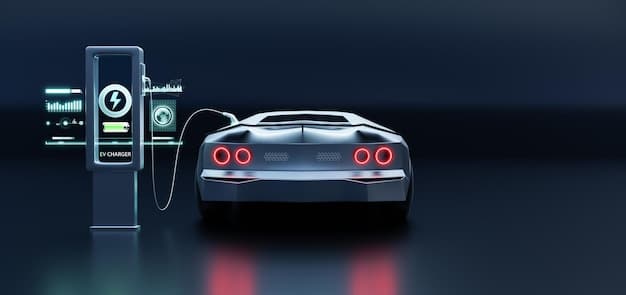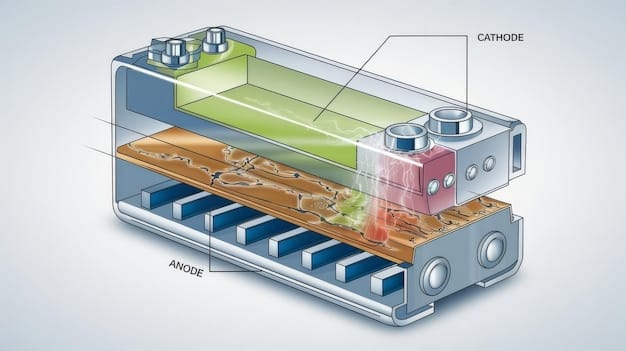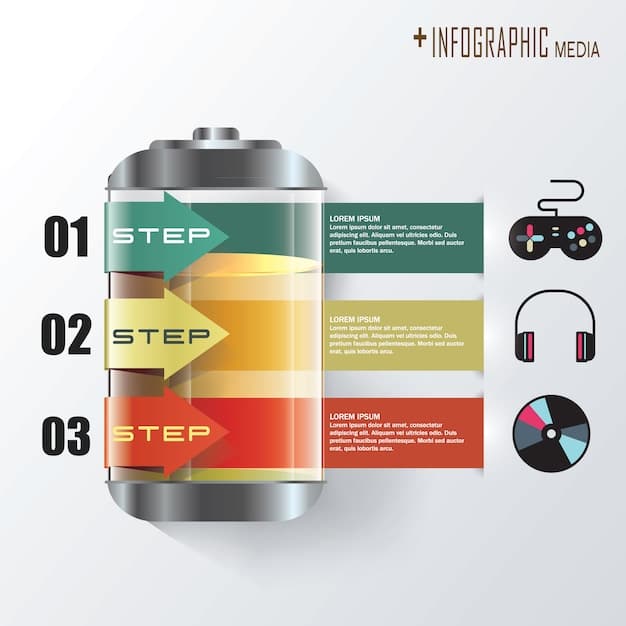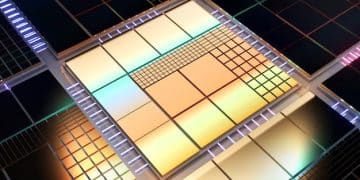Solid-State Batteries in US EVs: Real-World Performance Unveiled

Solid-state batteries in US electric vehicles promise enhanced safety and range, but their real-world performance regarding energy density, longevity, and cost-effectiveness is still under scrutiny, demanding thorough testing and data.
The automotive industry is buzzing about solid-state batteries, especially their potential to revolutionize electric vehicles (EVs). But what’s the **real-world performance of new solid-state batteries in US electric vehicles**? Let’s dive into the details and see if these batteries live up to the hype.
Understanding Solid-State Battery Technology
Solid-state batteries are the next frontier in energy storage, replacing the liquid electrolyte found in traditional lithium-ion batteries with a solid material. This change promises significant improvements, but understanding the specifics is crucial.
What Sets Solid-State Batteries Apart?
Unlike their lithium-ion counterparts, solid-state batteries use a solid electrolyte, which can be ceramic, glass, or a composite material. This key difference is at the heart of their potential advantages.
Key Benefits of Solid-State Batteries
The solid electrolyte brings several benefits, including improved safety, higher energy density, and faster charging times.
- Enhanced Safety: Solid electrolytes are non-flammable, reducing the risk of fires and thermal runaway, a common concern with lithium-ion batteries.
- Higher Energy Density: Solid-state batteries can potentially store more energy in the same volume, leading to longer driving ranges for EVs.
- Faster Charging: The solid structure allows for faster ion transport, which translates to quicker charging times.
These benefits could transform the landscape of electric vehicles, making them more appealing to a broader range of consumers.

Current State of Solid-State Battery Development in the US
Several companies in the US are heavily invested in solid-state battery development, each with its own unique approach and timeline. These advancements signal significant progress in the field.
Leading Companies in the Solid-State Battery Race
Companies like QuantumScape, Solid Power, and Factorial are at the forefront of developing and commercializing solid-state battery technology. Their progress is closely watched by the automotive industry.
QuantumScape’s Approach
QuantumScape, backed by Volkswagen, is focusing on a ceramic electrolyte and has reported promising results in early testing. They aim to deliver high energy density and fast charging capabilities.
Solid Power’s Strategy
Solid Power is developing sulfide-based solid-state batteries and has partnerships with Ford and BMW. Their approach is to create batteries that can be manufactured using existing lithium-ion battery production lines.
Factorial’s Innovation
Factorial is working on a solid electrolyte material that they claim can significantly improve energy density and stability. They’ve attracted investments from major automakers like Mercedes-Benz and Stellantis.
The competition among these companies is driving rapid innovation, bringing solid-state batteries closer to mass production.
Real-World Performance Metrics for US EVs
While lab results are promising, the real-world performance of solid-state batteries in US electric vehicles is what truly matters. Several key metrics determine their viability.
Energy Density and Range
One of the most critical metrics is energy density, which directly impacts the range of an EV. Solid-state batteries are expected to offer significantly higher energy density than current lithium-ion batteries.
Charging Time and Cycle Life
Charging time is another crucial factor for EV owners. Solid-state batteries have the potential to charge much faster, reducing the inconvenience of long charging sessions. Cycle life, or the number of charge-discharge cycles a battery can endure before degrading, is also vital.
Safety and Stability
Safety is paramount. The non-flammable nature of solid electrolytes should greatly reduce the risk of fires. Stability under various operating conditions, including extreme temperatures, is also essential.
These metrics will ultimately determine the success and adoption rate of solid-state batteries in the EV market.
Challenges and Roadblocks to Adoption
Despite the potential benefits, several challenges and roadblocks stand in the way of widespread adoption of solid-state batteries in US electric vehicles. Overcoming these hurdles is essential for their success.
Manufacturing Scalability
Scaling up the manufacturing process to produce solid-state batteries at the volumes required for mass-market EVs is a significant challenge. New manufacturing techniques and equipment will be needed.
Cost Considerations
Currently, solid-state batteries are more expensive to produce than lithium-ion batteries. Reducing the cost to a competitive level is critical for their commercial viability.
Material Availability
The availability of raw materials needed to produce solid electrolytes is another concern. Ensuring a stable and sustainable supply chain is crucial.
Addressing these challenges will require significant investment and collaboration between battery developers, automakers, and material suppliers.

Potential Impact on the US Electric Vehicle Market
The introduction of solid-state batteries could have a transformative impact on the US electric vehicle market, influencing consumer behavior and industry dynamics.
Increased EV Adoption
Longer driving ranges, faster charging times, and improved safety could make EVs more attractive to a wider range of consumers, accelerating their adoption.
Shift in Market Share
Automakers that successfully integrate solid-state batteries into their vehicles could gain a significant competitive advantage and shift market share.
Infrastructure Development
The need for faster charging infrastructure may drive investments in new charging technologies and widespread deployment of fast-charging stations.
These changes could reshape the automotive industry and accelerate the transition to electric mobility.
Future Outlook and Predictions
Looking ahead, the future of solid-state batteries in US electric vehicles is filled with both promise and uncertainty. Several trends and predictions are shaping the landscape.
Timeline for Commercialization
Most industry experts predict that solid-state batteries will begin to appear in limited production EVs by the mid-2020s, with more widespread adoption by the end of the decade.
Technological Advancements
Ongoing research and development efforts are expected to further improve the performance and reduce the cost of solid-state batteries.
Government Support and Investment
Government policies and investments in battery technology will play a crucial role in accelerating the development and deployment of solid-state batteries.
The next few years will be critical in determining the ultimate success and impact of solid-state batteries in the US electric vehicle market.
| Key Point | Brief Description |
|---|---|
| ⚡️ Safety Improvement | Non-flammable electrolytes reduce fire risk. |
| 🚗 Range Increase | Higher energy density extends driving range. |
| ⏱️ Faster Charging | Quicker ion transport speeds up charging. |
| 💰 Cost Hurdles | Reducing production costs is critical. |
Frequently Asked Questions
▼
Solid-state batteries use a solid electrolyte instead of the liquid electrolyte found in traditional lithium-ion batteries, offering potential improvements in safety and energy density.
▼
The solid electrolyte is non-flammable, significantly reducing the risk of fires and thermal runaway compared to the flammable liquid electrolytes in lithium-ion batteries.
▼
Key challenges include scaling up manufacturing, reducing production costs, and ensuring the availability of raw materials for the solid electrolytes.
▼
Most experts predict limited production EVs with solid-state batteries by the mid-2020s, with more widespread adoption expected by the end of the decade.
▼
They could increase EV adoption by offering longer ranges, faster charging, and improved safety, potentially shifting market share and driving infrastructure development.
Conclusion
Solid-state batteries hold immense promise for the future of electric vehicles in the US. While challenges remain in scaling production and reducing costs, the potential benefits in terms of safety, range, and charging speed make them a key technology to watch in the coming years. The advancements in solid-state battery technology could truly reshape the electric vehicle landscape.





